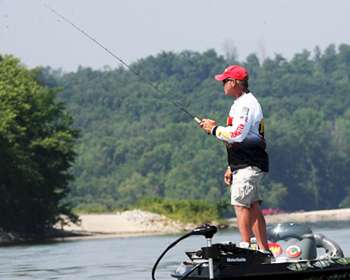
Just like a golfer with a favorite club or a pitcher with a go-to pitch, bass anglers have their versions of reliable tactics that always seem to produce. When the livewell needs a few new additions, these tactics pay off in the clutch. For Elite Series pro Mark Tucker, his go-to offering is a finesse jig.
When prowling clear water lakes, like Table Rock in his home state of Missouri, Tucker can often be found tempting suspended bass with the bite-sized morsel. For Tucker, the finesse jig is a lure with year-round applications. Prespawn, postspawn, summer, fall and winter are all times when he will have a finesse jig tied on.
The only exception is during the spawn, when he will opt for a different presentation to catch bass protecting beds. What's more, Tucker has caught bass on the finesse jig from coast to coast — wherever the water is fairly clear. "You usually need a fishery that has rock and crawfish," he explains. "But there are times bass mistake the finesse jig for a bluegill or baitfish."
When fishing for bass on a finesse jig during late summer and early fall, Tucker typically targets bass holding on bluffs. "The finesse jig is a lot lighter than a football jig, so I generally don't target fish in really deep water," he says. "During summer I'll just parachute that finesse jig off the bluffs." Often, bites will come as the jig falls down the face of the bluff.
When fishing a lake with floating docks, he will also utilize the finesse jig to score bass that are using docks for cover and shade. "Boat docks in the summer are a really productive pattern as long as you are fishing the shaded side of the docks and getting the finesse jig way back into places where you can't get a big jig with heavy line," Tucker says. Rather than let the jig fall to the bottom, he likes to swim the jig around the floating docks to catch suspended bass that are feeding on baitfish.
Color selection is another factor that the Missouri pro takes into consideration when fishing a finesse jig. Typically, he uses natural colors like green pumpkin or brown, but in certain cases he will reach for a black and blue jig. "On a cloudy day, even in clear water, black and blue will produce because it's easier for the bass to locate. Plus, I don't think a lot of other anglers are throwing that color in clear water," he explains.
Most of the time, Tucker opts for a 3/16-ounce jig; he steps up to a 5/16-ounce jig in windy conditions. His jig of choice is either a Jernigan Jig or Tru-Tungsten finesse jig. "If I'm throwing a finesse jig, it's going to be in one of those two weights," he says. Depending on water clarity and the activity level of the bass, Tucker will dress his finesse jig with either a Zoom Critter Craw or Zoom Super Chunk Jr. "If I can't get bit on the Critter Craw, it's because that's too subtle," he explains. "If the water gets a little color to it, bass seem to want something that's pushing more water — that's when I'll go with the Super Chunk Jr."
When there's money on the line, Tucker says that there isn't a bait in his boat that he has more confidence in than the finesse jig. "That's what I do," he says. "Sometimes it ends up costing me, but the quality of bass that I catch on a jig is usually a lot better. Plus, once I hook a fish on a jig, I know it's going to make it into the boat."




